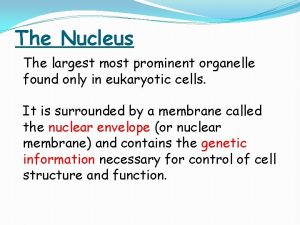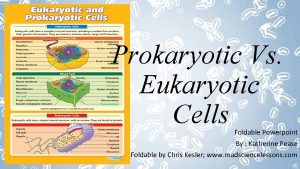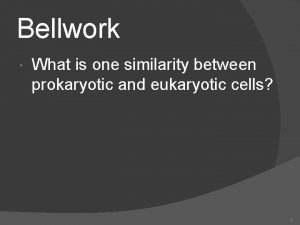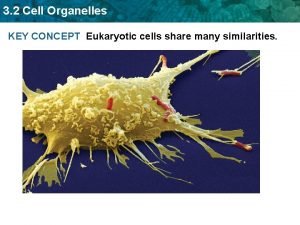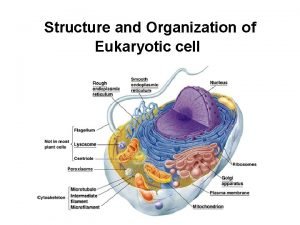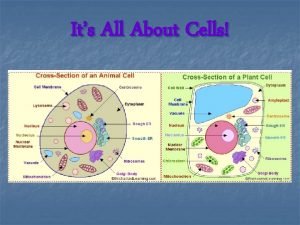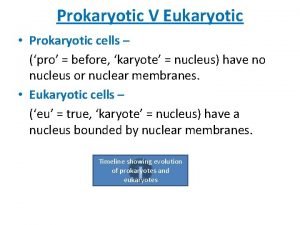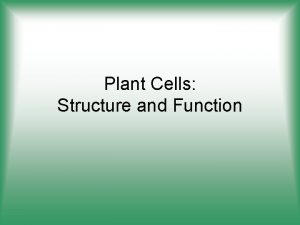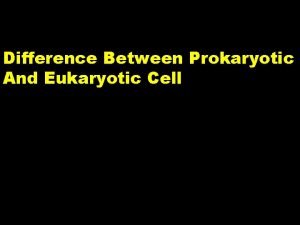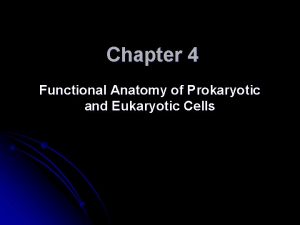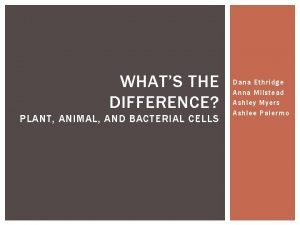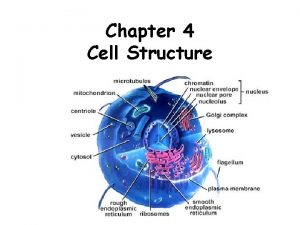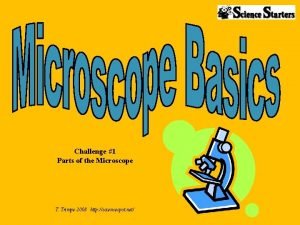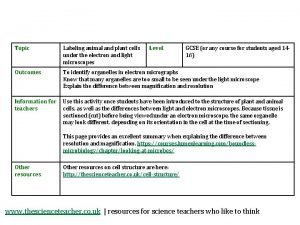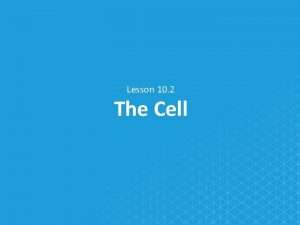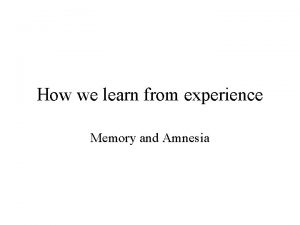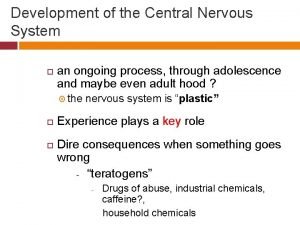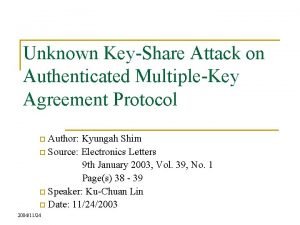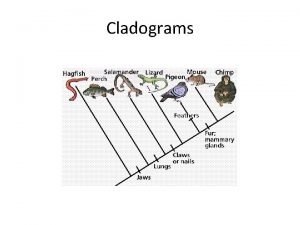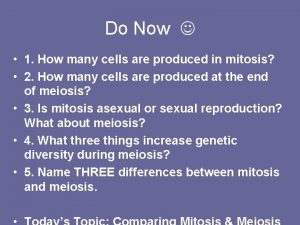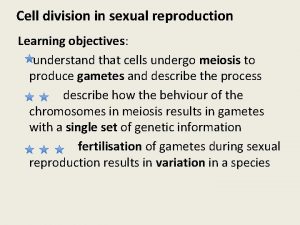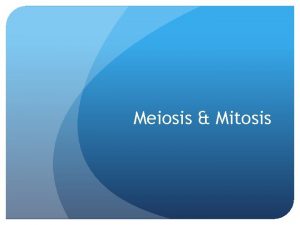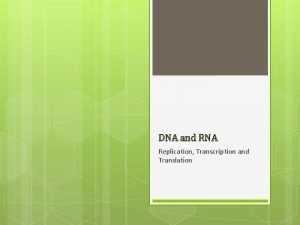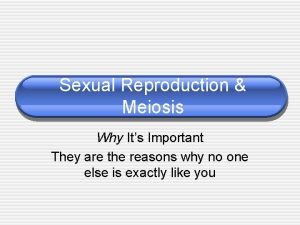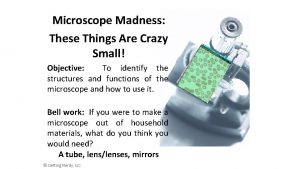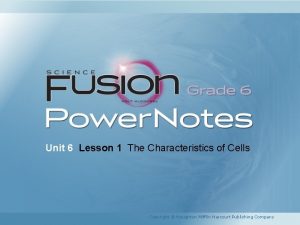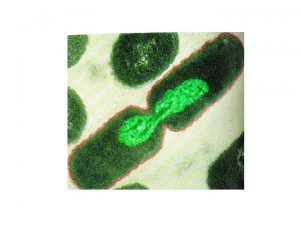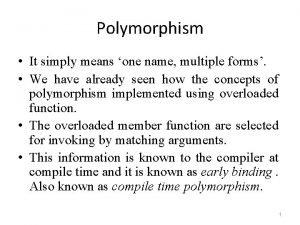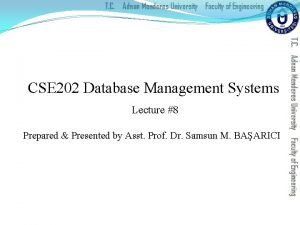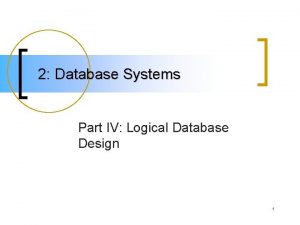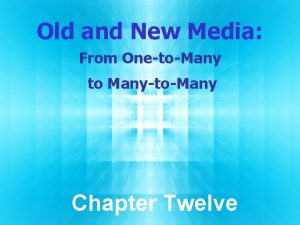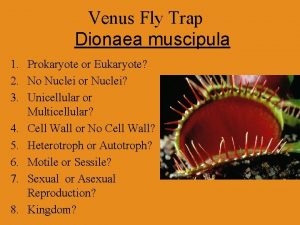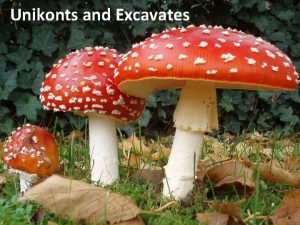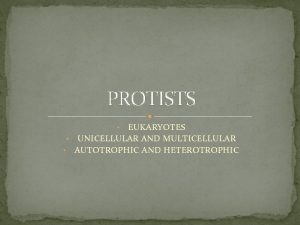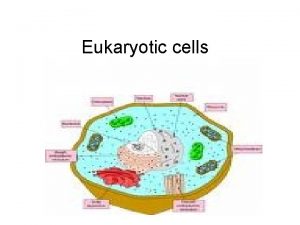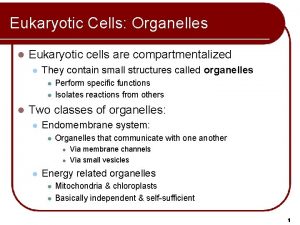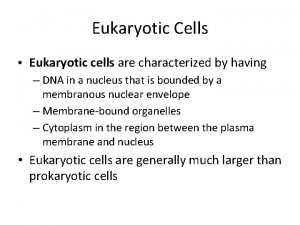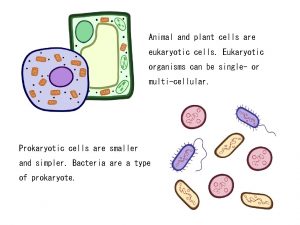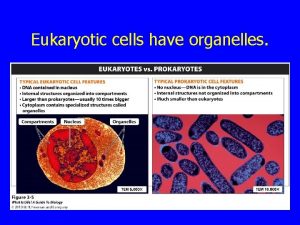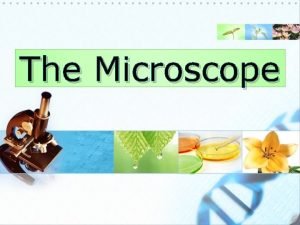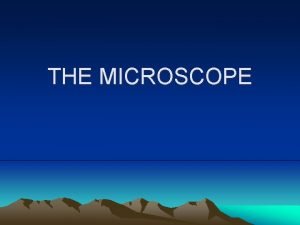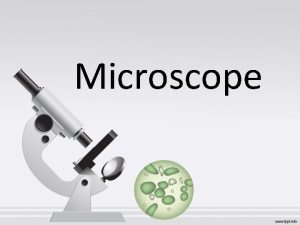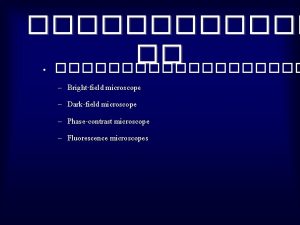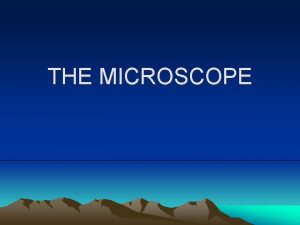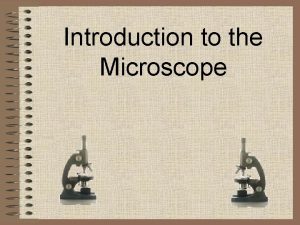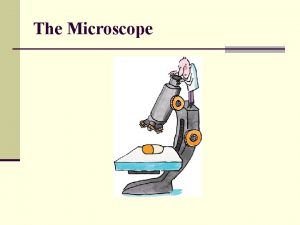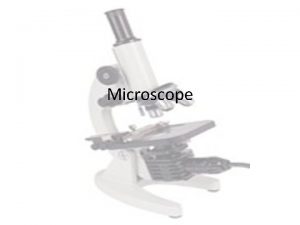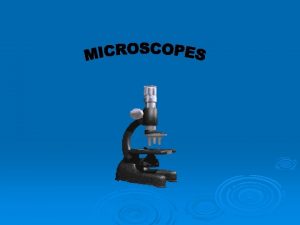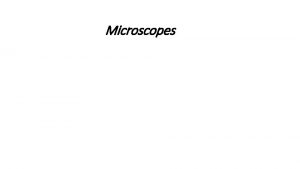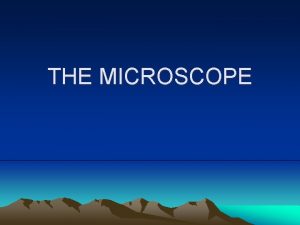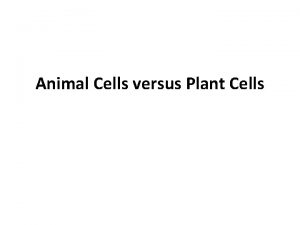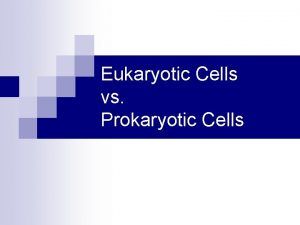KEY CONCEPT Eukaryotic cells share many similarities Microscope














































































- Slides: 78

KEY CONCEPT Eukaryotic cells share many similarities.


Microscope- tool used to enlarge images that are small like bacteria • Lead to the discovery of cells • Robert Hooke used the microscope to identify and name cells

A. Organisms are made up of one or more cells

B. The cell is the smallest unit of life.

C. New cells come from other living cells by the process of cell division

A. How the first cells arise? There is no explanation B. Viruses: are not true cells and they are not alive. They do not have all life functions C. Viruses need other cells to reproduce

Remember: Unicellularone cell: bacteria Multicellular- Many cells- Most organisms

General Characteristics of Cells: All Cells Have… Cell membrane Gate keeper Cytoplasm Metabolism Nuclear material Instructions (DNA)

Prokaryotic vs. Eukaryotic Bacteria Animals Plants

Prokaryotic vs. Eukaryotic • Small cells • No nuclear membrane • No nucleus • Large cells • Many membranebound organelles. • Have a nucleus

Cells come in a variety of shapes!

Cells come in a variety of shapes!

Shape of cell determines its function.

(Plasma Membrane) A. Structure: A lipid bilayer with a variety of proteins

Proteins Lipid molecule

(Plasma Membrane) B. Function: -Homeostasis(balance) -Selective Permeability: controls what enters and exits the cell

(Plasma Membrane) C. Protein Function: Channels for the passage of materials


Cell walls


Cell Wall– Only found in plant cells • Made of Cellulose (carbohydrate) • Function: provides the plant cell with a rigid structure and support.




Nucleus • Controls cell activities & stores DNA material • Nuclear Envelope: Protects the nucleus Nuclear Pores: Openings on the surface of the nucleus

Nucleolus • Inside of the nucleus • Makes ribosomes





Cytoplasm • Jelly-like substance made of water • All of the organelles are suspended in it. • Function: is the center for most of the cells metabolic activity. It is where metabolism takes place.

Endoplasmic Reticulum • Production of lipids • Highly folded membranes Rough vs Smooth • Can be rough: With Ribosomes • Smooth: Without Ribosomes





Vesicles • Small membrane-bound sacs that transports them within the cell

Vesicles are membrane-bound sacs that hold materials.

ribosome new protein endoplasmic reticulum

Rough Vs. Smooth ER

Ribosomes • Are sites where the cell produces proteins • Some float freely in cytoplasm • Some are attached to the Endoplasmic Reticulum



Golgi Apparatus( Body) • After proteins are made by the Ribosomes • They are transferred to Golgi Apparatus, where proteins are sorted and packaged and sent out where they are needed • Mail office




How organelles work together • • Nucleolus – makes ribosomes Ribosomes- make proteins ER- Transports Proteins Golgi apparatus- sorts & packa ges & ships proteins to where they are needed • Mitochondria- provides energy for the entire process. • ENDOMEMBRANE SYSTEM

THE MIGHTY--Mitochondria • Produce energy (ATP) using enzymes • Power house of the cell • Breaks down nutrients (glucose) during the process of cellular respiration to make energy


Mitochondrion cristae inner membrane outer membrane

• Cristae- folds designed to increase surface area to increase energy (ATP) release • They are located inside the Inner Membrane


Lysosomes • Takes out Trash • Contains digestives enzymes • Digest worn out organelles, food particles, viruses and bacteria • Animal cell only





Centrioles • Structure that produces Microtubules to form Flagella and Cilia • ASSIST in CELL DIVISION (mitosis) **Animal Cell ONLY




Cytoskeleton

Movement Filaments • Both Assist in cell Movement • Cilia- short hair like projections • Flagella- long projectionssperm • Common in single celled organisms like bacteria

Microtubules & Cytoskeleton • They make up the cell’s support and movement system • Similar to the bones in our body



Bacteria with flagella




Vacuole • Sacs for temporary storage of materials • It stores: food, enzymes, and even wastes • Central Vacuole in plant cells only (large).


Chloroplast • Only found in plant cells • Contains Chlorophyll- green pigment • Location of the process of photosynthesis • Capture and covert Light energy into usable energy (glucose)



The end…. . Next Topic: Cell transport
 3 parts of cell theory
3 parts of cell theory Similarities between prokaryotic and eukaryotic cells
Similarities between prokaryotic and eukaryotic cells Eukaryote examples
Eukaryote examples Prokaryotes vs eukaryotes venn diagram
Prokaryotes vs eukaryotes venn diagram 4 types of eukaryotic cells
4 types of eukaryotic cells Prokaryotic cell wall
Prokaryotic cell wall Prokaryotic cell and eukaryotic cell similarities
Prokaryotic cell and eukaryotic cell similarities Most prominent organelle in eukaryotic cells
Most prominent organelle in eukaryotic cells Eukaryotic cells
Eukaryotic cells Diff between prokaryotes and eukaryotes
Diff between prokaryotes and eukaryotes Similarity between prokaryotic and eukaryotic cells
Similarity between prokaryotic and eukaryotic cells Organelles in eukaryotic cells worksheet
Organelles in eukaryotic cells worksheet Eukaryotic cells
Eukaryotic cells Are eukaryotic cells living or nonliving
Are eukaryotic cells living or nonliving Answers
Answers Prokaryotes vs eukaryotes chart
Prokaryotes vs eukaryotes chart Prokaryotic and eukaryotic difference
Prokaryotic and eukaryotic difference Eukaryotic plant cell diagram
Eukaryotic plant cell diagram Difference between prokaryotic and eukaryotic cells
Difference between prokaryotic and eukaryotic cells Anatomy of prokaryotes and eukaryotes
Anatomy of prokaryotes and eukaryotes Parts of a cell graphic organizer
Parts of a cell graphic organizer Plant and animal cells similarities
Plant and animal cells similarities All cells exhibit basic structural similarities
All cells exhibit basic structural similarities Animal cell venn diagram
Animal cell venn diagram Difference between light microscope and electron microscope
Difference between light microscope and electron microscope Microscope mania compound light microscope
Microscope mania compound light microscope Animal cell under microscope labeled
Animal cell under microscope labeled Lumen
Lumen Rosa uses a microscope to look at a group of cells
Rosa uses a microscope to look at a group of cells Sphenoid paranasal sinus
Sphenoid paranasal sinus Papillary duct of bellini
Papillary duct of bellini Thyroid gland
Thyroid gland Gamete vs somatic cell
Gamete vs somatic cell Why dna is more stable than rna?
Why dna is more stable than rna? Chlorocruorin
Chlorocruorin Organelle trail
Organelle trail Masses of cells form and steal nutrients from healthy cells
Masses of cells form and steal nutrients from healthy cells Younger cells cuboidal older cells flattened
Younger cells cuboidal older cells flattened Chapter 8 cellular reproduction cells from cells
Chapter 8 cellular reproduction cells from cells Cells cells they're made of organelles meme
Cells cells they're made of organelles meme Key concept summaries answer key
Key concept summaries answer key Key concept builder lesson 1 what are waves answer key
Key concept builder lesson 1 what are waves answer key Concept cells
Concept cells Neural groove
Neural groove Unknown key share attack
Unknown key share attack Revenue streams example business model canvas
Revenue streams example business model canvas Key partners key activities key resources
Key partners key activities key resources Cladogram human
Cladogram human How many cells are in a swot matrix
How many cells are in a swot matrix How many cells are produced in meiosis? *
How many cells are produced in meiosis? * How many chromosomes
How many chromosomes Meiosis
Meiosis How many cells are in the human body
How many cells are in the human body How many chromosomes are in a human’s sex cells?
How many chromosomes are in a human’s sex cells? Microscope madness vocabulary answer key
Microscope madness vocabulary answer key Lesson 1 the characteristics of cells answer key
Lesson 1 the characteristics of cells answer key Types of tissue in the body
Types of tissue in the body Looking inside cells answer key
Looking inside cells answer key Cells and life lesson 1 answer key
Cells and life lesson 1 answer key Garland key dead cells
Garland key dead cells Explain ideal self
Explain ideal self Pengertian marketing concept
Pengertian marketing concept One name many forms
One name many forms Perfect competition 4 conditions
Perfect competition 4 conditions Er model
Er model Convert conceptual model to logical model
Convert conceptual model to logical model Erd vs erm
Erd vs erm Unary many to many
Unary many to many Erd film
Erd film Unary many to many
Unary many to many Many-to-many communication
Many-to-many communication Sqlbi many to many
Sqlbi many to many Unary many to many
Unary many to many Many sellers and many buyers
Many sellers and many buyers Venus fly trap prokaryotic or eukaryotic
Venus fly trap prokaryotic or eukaryotic Eukaryotic supergroups
Eukaryotic supergroups Eukaryotic, unicellular, and autotrophic
Eukaryotic, unicellular, and autotrophic Eukaryotic vs prokaryotic transcription
Eukaryotic vs prokaryotic transcription Prokaryotic vs eukaryotic cell
Prokaryotic vs eukaryotic cell







